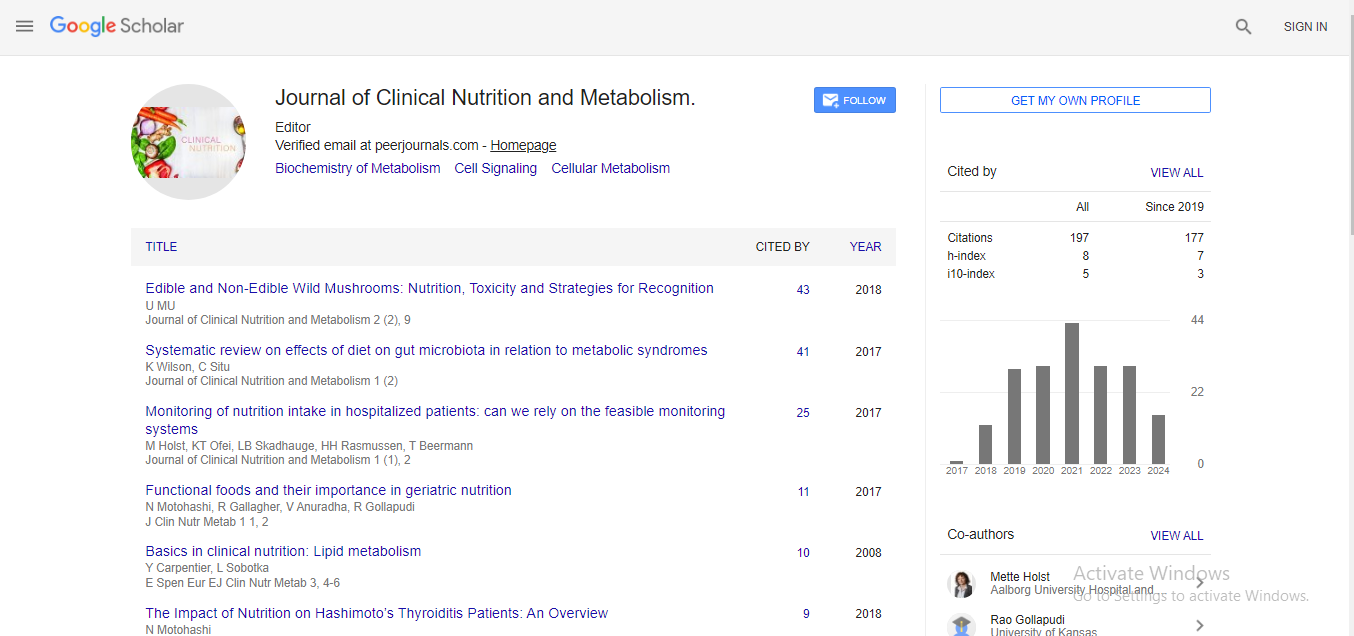Commentary, J Clin Nutr Metab Vol: 5 Issue: 5
Human Nutrition and Food Choice of Older Adults
Jenkins MN*
National Institute of Standards and Technology, MD 20899, US
- *Corresponding Author:
- Jenkins MN
National Institute of Standards and Technology, MD 20899, USE
E-mail: a.fawzy25@yahoo.com
Received Date: September 06, 2020; Accepted Date: September 25, 2021; Published Date: October 01, 2021
Citation: Jenkins MN (2021) Human Nutrition and Food Choice of Older Adults. J Clin Nutr Metab 5:5. 126.
Copyright: © All articles published in Journal of Clinical Nutrition and Metabolism are the property of SciTechnol and is protected by copyright laws. Copyright © 2020, SciTechnol, All Rights Reserved.
Keywords: Human Nutrition
Commentary
Human nutrition deals with the availability of essential nutrients in food those area units necessary to support human life and healthiness. Poor nutrition could be a chronic downside usually coupled to financial condition, food security, or a poor understanding of biological process needs. Deficiency disease and its consequences area unit giant contributors to deaths, physical deformities, and disabilities worldwide. Smart nutrition is important for youngsters to grow physically and mentally, and for traditional human biological development. The physical body contains chemical compounds like water, carbohydrates, amino acids (found in proteins), fatty acids (found in lipids), and nucleic acids (DNA and RNA). These compounds area unit composed of components like carbon, hydrogen, oxygen, nitrogen, and phosphorus. Any study done to work out biological process standing should take under consideration the state of the body before and once experiments, further because the chemical composition of the entire diet and of all the materials excreted and eliminated from the body (including body waste and feces). The seven major categories of nutrients area unit carbohydrates, fats, fibre, minerals, proteins, vitamins, and water. Nutrients are sorted as either macronutrients or micronutrients (needed in little quantities). Carbohydrates, fats, and proteins area unit macronutrients, and supply energy. Water and fiber area unit macronutrients however don’t offer energy. The micronutrients area unit minerals and vitamins.
Food preferences in older adults and seniors takes into thought however people’s experiences modification with aging; that’s, changes in style, diet (nutrition) and food alternative. Primarily, this happens once the general public approach the age of seventy or older. Influencing variables will include: social and cultural setting, male or feminine sex and private habits further as physical and mental state. Scientific studies making an attempt to clarify why individuals like or dislike sure foods are performed to more our understanding of those problems. Analysis is unendingly examining the variables that cause the old to alter food preferences, one example being the old Nutrition Program (ENP). To enhance the standard of meal programs, the ENP explored however food preferences varied counting on biological sex and ethnic teams. A complete of two, 0.24 participants within the ENP aged sixty years or older were interviewed. A majority of the participants were feminine, served by congregate meal programs, or meals served in community settings like senior centers, churches or senior housing communities. A general impression of the meals and preferences for thirteen food teams (fresh fruit, chicken, soup, salad, vegetables, potatoes, meat, sandwiches, pasta, canned fruit, legumes, deli meats, and ethnic foods) were assessed. Once adjusting for variables, older male subjects were found to be considerably a lot of possible to like store meats, meat, legumes, canned fruit, and ethnic foods compared to females. Additionally, compared with African Americans, the study found that “... Caucasians incontestable higher percentages of preference for nine of thirteen food teams together with food, meat, and recent fruit”, and suggested that “... to enhance the standard of the ENP, and to extend dietary compliance of the older adults to the programs, the biological process services need a strategic plan that solicits and incorporates older adults’ food preferences”
With age, some individuals tend to avoid food or area unit unwilling to change their diets because of oral health issues. These problems, like ill-fitting dentures (false teeth) or gum wellness, area unit related to vital variations in dietary quality, that could be a live of the standard of the diet employing a total of eight recommendations relating to the consumption of foods and nutrients from the National Academy of Sciences (NAS). Approaches to reduce food dodging and promote changes to the diets of individuals that have consumption difficulties because of oral health conditions area unit required urgently as a result of while not having the ability to chew or soak up food properly, their health is settled drastically and their food preferences area unit restricted greatly (to soft or liquids only). The impact of sure diseases can even impact the standard of the food within the old population, particularly people who area unit in care facilities. Sure risk factors embody conditions that impair psychological feature operate, like dementedness. Once an individual falls victim to a condition that limits intelligence, mortality risk will rise if guardianship isn’t enforced. As a results of sure mental state conditions and/or diseases— like Alzheimer’s—a person’s food preferences would possibly become affected. With sure diseases, people will develop specific preferences or dislike for numerous kinds of food that weren’t gift before onset. For instance, individuals with Alzheimer’s disease could expertise several huge and tiny changes as results of their symptoms. One modification known by Suszynski in “How dementedness Tampers With style Buds” is among the style buds of a patient with dementedness, that contain the receptors for style. Since the expertise of flavor is considerably altered, individuals with dementedness will usually modification their consumption habits and combat entirely new food preferences. During this study, the researchers found that these dementedness patients had bother distinguishing flavors and perceived to have lost the power to recollect tastes, so resulting in a theory that dementedness caused the patients to lose their data of flavors.
 Spanish
Spanish  Chinese
Chinese  Russian
Russian  German
German  French
French  Japanese
Japanese  Portuguese
Portuguese  Hindi
Hindi 